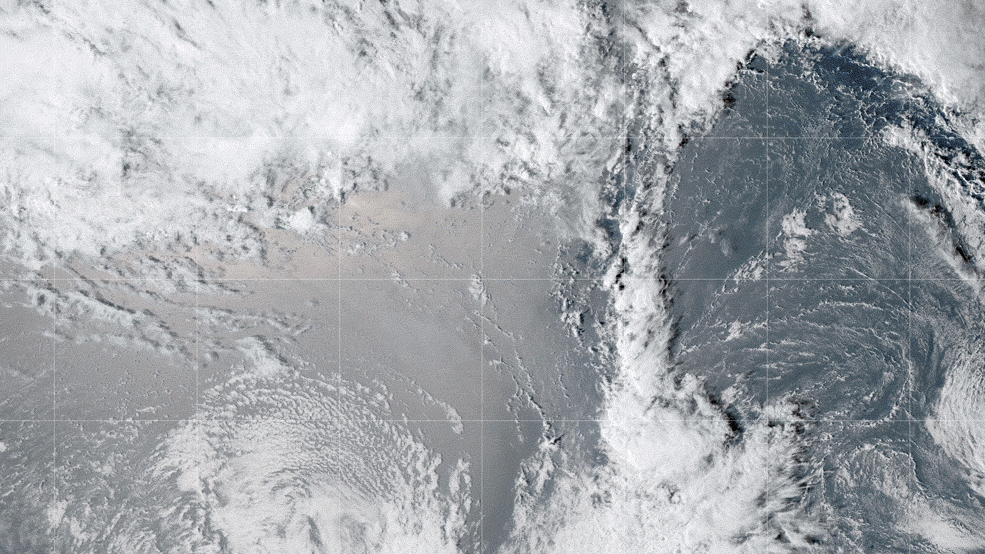The most intense lightning ever seen came from the Tonga volcano eruption last year



The Tonga Hunga volcanic eruption as seen by a GOES satellite. Credit: NOAA, NESDIS.
The huge underwater volcano that erupted in Tonga last year broke records in many respects. It generated the tallest volcanic plume ever recorded, triggered a sonic boom that circled the globe twice, and was the most powerful natural explosion in more than a century.
Now, scientists studying the eruption say the volcanic plume created record amounts of volcanic lightning, the most intense lightning rates ever documented in Earth’s atmosphere. While the ash obscured view, satellites and ground-based radio antennas with specialized instruments could peer through the ash and see each stage of the eruption unfolding. More than 200,000 lightning strikes were detected in the volcanic column, more than 2,600 lightning strikes per minute.
The researchers used high-resolution lightning data from five sources, never before used together, allowing them to gain insight into the intense weather it created.
“This eruption unleashed a supercharged thunderstorm, the likes of which we’ve never seen before,” said Alexa Van Eaton, a volcanologist with the United States Geological Survey and lead author of a new study published in Geophysical Research Letters .
When the Hunga Tonga-Hunga Ha’apai volcano erupted on January 15, 2022, it launched a gigantic volcanic plume that rose into the mesosphere, reaching a height of 57 kilometers (35 miles). It triggered tsunamis of up to 90 meters (300 feet) and atmospheric waves that circled the entire planet twice.

The Tonga eruption in 2022 sent ash and water into the air and created an atmospheric pressure wave that helped create an equatorial plasma bubble that disrupted satellite communications that depend on the ionosphere. Courtesy of the Himawari-8 satellite.
But the eruption also formed its own weather system that created more lightning than any documented storm on Earth so far, including supercells and tropical cyclones.
“With this eruption, we found that volcanic plumes can create the conditions for lightning well beyond the scope of the weather storms we have previously observed,” Van Eaton said in an AGU news release . “It turns out that volcanic eruptions can create more extreme lightning than any other type of storm on Earth.”
The researchers used visible and infrared observations from two geostationary satellites: GOES-17 and Japan’s Himawari-8. GOES-17 also has a Geostationary Lightning Mapper (GLM) that uses pixel mapping to obtain the time, location, flash area, and optical brightness of lightning. They also used a combined data set from three terrestrial networks of radio antennas: the Global Lightning Data suite from Vaisala, a Finnish company that makes climate, environmental, and industrial measurements, and Earth Networks Total Lightning Network (ENTLN), which incorporates data from the World Wide Lightning Location Network (WWLLN).

Satellite and volcanic lightning timeline of the eruption of Hunga volcano in Tonga on January 15, 2022. Four phases of eruptive activity can be distinguished using umbrella cloud growth, maximum plume heights, and lightning rates. Credit: Van Eaton, et al, Geophysical Research Letters.
The combined power of the satellites and radio antennas detected optically bright lightning strikes at unusually high altitudes, in regions of the volcanic cloud 20 to 30 km above sea level. This is activity at a height never seen before. They also observed continuous and sustained electrical activity at rates not previously measured.
“The eruption lasted much longer than the hour or two initially observed,” Van Eaton said. “The activity on January 15 created volcanic plumes for at least 11 hours. It was really only by looking at the lightning data that we were able to get that out.”
The lightning provided information not only about the duration of the eruption, but also about its behavior over time. The researchers observed four distinct phases of eruptive activity, defined by the heights of the plumes and the speeds of lightning as they increased and decreased.
There were also concentric rings of rays, which expanded and contracted over time.
“The scale of these rings of lightning blew us away,” Van Eaton said. “We have never seen anything like this before, there is nothing comparable in weather storms. Single, but not multiple, rings of rays have been observed, and they are tiny by comparison.”
Overall, the researchers said remote lightning sensing contributed to a detailed timeline of this historic eruption and, more generally, now provides a valuable tool for monitoring and “forecasting now” the hazards of explosive volcanism across the globe. world.
“These findings demonstrate a new tool we have to monitor volcanoes at the speed of light and help the USGS role in reporting ash advisories for aircraft,” Van Eaton said.




